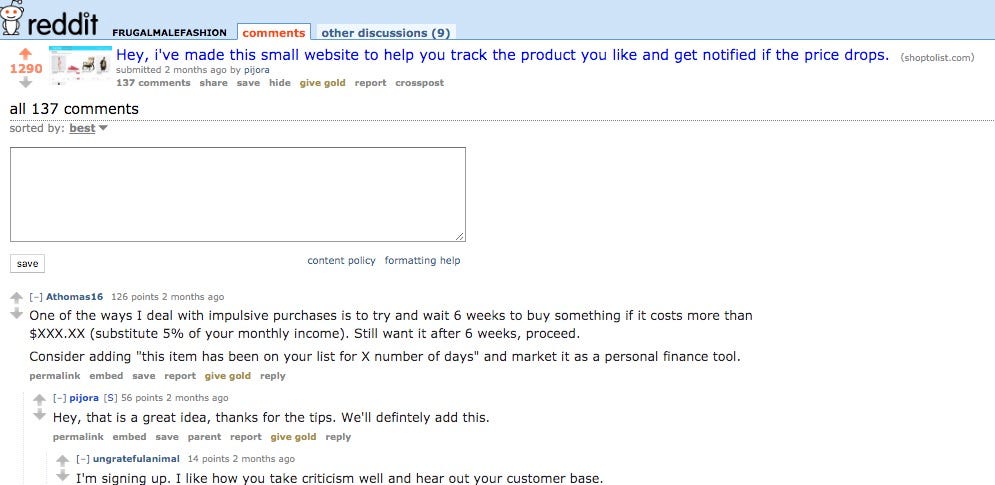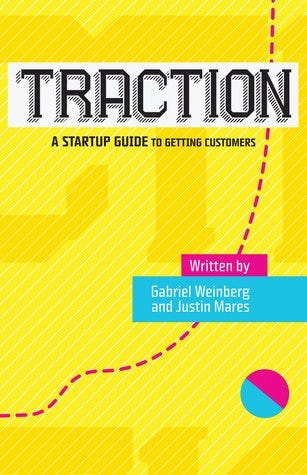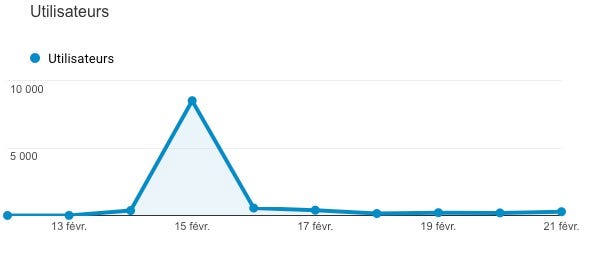Latest news about Bitcoin and all cryptocurrencies. Your daily crypto news habit.

I know I know, developers hate marketing. After months of coding, you deploy your website, and you think people will come. Mmh, that’s not going to happen. My partner Pierre De Wulf and I launched ShopToList 3 months ago, we did a spectacular Reddit launch, got 1200 users in a week, and then this happened:
Shoptolist is a universal wish list. It allows you to track the products you want to buy, and get notifications if the price drops. Think Pocket, but for shopping.
So two days after one of our reddit posts went “viral” (1000+ upvotes, lots of comments), the traffic went close to zero. We had to do something. We read everything we could about marketing, and we began to test different strategies. In this post, I will show you what worked, and what didn’t.
We are not marketing experts at all, but we managed to grow our user base by 300% using these techniques.
To know more about the context, ShopToList is a side project for us, we are 100% bootstrapped, and we don’t have a lot of budget to spend on marketing.
Know your target
Before doing any marketing, the first thing to do is to think about who are your users. To know this, we did two things. First, we asked them different questions, by sending them a Google Form, to understand how they use the product. And then we looked at the data we had. Meaning how many product users add on ShopToList, what kind of product, what price ranges etc.
With ShopToList, our target user is a heavy e-commerce customer, willing to buy things at the best price. It means we don’t target impulsive buyers. There are lots of niche communities that fit our target :
- Coupons hunters
- Deals
- Frugal
- FIRE enthousiasts( Financial Independance Retire Early)
- “Big purchase”: Fridge, Laptop, Graphic Cards…
Online Communities
The first thing we did was posting a short message on specific subreddits like:
- Fashion subreddit
- Startup / Entrepreneur subreddit, to ask for feedback and beta testers
- Entrepreneur Forums
 Our best Reddit post
Our best Reddit post
Reddit performed REALLY well for us. Pierre and I are long time Redditors, so we knew the platform very well. We knew we had to be careful, so every time we did self-promotion we didn’t try to hide it. Most of the time mods approved the message, and we gather a lot of users and most importantly feedback.
Bloggers
We searched on Google some blog directories in the different niches that interested us. Then we send an email to all of them (600+) telling them how ShopToList would be great for their audience.
On the 600 bloggers we have sent an email to, about 20 responded and asked for a little fee (50–150$) to write a review of ShopToList. We agreed with 2 of them; we thought their traffic was excellent, and having some backlinks could be useful for SEO purpose.
Unfortunately, the results were terrible, we only got a few clicks from these articles.
Facebook groups
We posted links to ShopToList in many Facebook groups (like 50+) and got a little bit of traffic, maybe 1% of our total traffic comes from Facebook groups.
This process took us a lot of time. Because had to look for the “good” Facebook groups, meaning groups that were in our target communities, without rules against self-promotion, and with an engaged community.
Lots of Facebook groups have become some kind of “links dumpster” where people just ignore everything because there are 50+ trash links posted every day. So again, the results were terrible.
Quora
We looked for non-answered / non-complete questions on Quora about different topics where ShopToList was a good fit like :
- How to save money online ?
- What are good alternatives to **name of a competitor** ?
- Where can I find the best online sale for ** some product** ?
Quora performed better than posting on Facebook groups because we managed to get “recurring” traffic from those answers.
Some Quora questions rank very well on Google, and if you get enough upvotes to be one of the first answers, it can be a massive acquisition channel. Of course, the key is to provide quality answers, don’t just throw some links to your product, but explain why it perfectly fits what the user is asking.
Youtubers
We looked for Youtube channels that could talk about ShopToList in one of their videos, meaning Shopping YouTubers, Frugal / FIRE channel. We didn’t want to target “big” Youtubers because we learned that there often was an agent/agency behind them to manage their partnership, so we contacted a list of 40 Youtubers, from 10k subscribers to 100k, and we only got one response, from an agent, willing to know how much we could pay for a partnership.
We were a bit naive about Youtubers and bloggers, we thought we could just ask them to try our website and talk about us for free, but unfortunately they receive too many requests, so basically everyone ask for money and paid partnership.
Paid Advertising
We tried some advertising on Adwords, Facebook, and Reddit. To summarize, we are not ad experts at all, it’s a big topic where a lot could be said like A/B testing ads, targeting / retargeting, etc, and we didn’t do all of that, but the thing is, we quickly realized that paid traffic is not a good fit for a “free” B2C website.
Our revenue is so little (~100$/month), and we don’t have any reliable data about user retention yet (it’s been only three months since we are live) that we can’t calculate any ROI from paid traffic. So spending $0.3-$1 for a click is way too expensive for us.
Other thing we are going to try
Referrals
From the beginning we wanted to add a referral mechanism into ShopToList. We then looked at how others did that. In most paid B2C product or SAAS, both parties get a discount on the product, like one month for free, or some kind of free credit for the service. So there is an incentive for existing users to share their referral code, and for their friends to accept the invitation and create an account.
But in our case, we asked ourselves how could create an incentive for sharing a registration link given the fact that our product is free to use. We looked at some free B2C services, and some people are restricting features if you don’t invite a friend through a referral link.
So maybe we could limit the product we allow people to track on ShopToList, and ask users to share their referral link to get unlimited product tracking. But that would mean we would “punish” our most active users, that’s why we didn’t go that way. We don’t really know how we are going to do this, but one way or another, we think we really need a referral mechanism.
Two valuable lessons from THE book
 Buy it on Amazon (non affiliate link)
Buy it on Amazon (non affiliate link)
Of all the book we read, the most useful was without a doubt Traction by Gabriel Weinberg (DuckDuckGo founder and CEO). I highly recommend you to read it as we learned many valuable lessons from it. We will discuss it further in our next blog post, but there are two things you can take right now from this book:
Find you critical path
Find your critical path between where you are and where you want to be concerning the number of users. Your critical path is the shortest path regarding features that will allow you to reach your traction goal. This means that if your short-term goal is to have 20 000 users, you have to decide beforehand what should be integrated into your product to reach that goal. Do you think you need a mobile app? Do you think you need this social feature? Do you think you need to improve the design? Etc… Answers to those questions make the critical path. When your startup is at an early stage, you have very limited resources, this is why choosing what to do and more importantly what not to do is very important, and this is the sole purpose of the critical path.
Stick to it
Once you have found an effective channel, stick with it and be creative. When starting your traction strategy, it can be very tempting to try a lot of things because there are a lot of stuff to try: social advertising, google ads, blog advertising, content marketing, affiliate programs, trade shows, offline events …
You might want to run with the hare and hunt with the hounds, and it is a bad idea, if you find a good hound, stick with it. As soon as one strategy is successful, even a little, try to improve it and exploit it till exhaustion, only then switch the channel. It does not mean that you can’t use multiple channels at the same time, just try your best to optimize the one you use before ruling them out.
Basically, if you find that targeting blog works for you, try to tweak the blog you target or the content you publish or the call to action before being done with this channel. It might sound obvious, but for example with ShopToList (link), we overlooked that tweaking process and lost a bit of time and money wandering in other channels. By optimizing the current process, we had much better results.
I hope you liked this article, we regularly write about our journey in the startup world. You can check out our last post (30k readers ! ) :
How we launched our first MVP in one month
Thanks for reading, if you enjoyed this article, feel free to click the 👏 button to help others find it, and to follow me :)
Marketing 101 for developers was originally published in Hacker Noon on Medium, where people are continuing the conversation by highlighting and responding to this story.
Disclaimer
The views and opinions expressed in this article are solely those of the authors and do not reflect the views of Bitcoin Insider. Every investment and trading move involves risk - this is especially true for cryptocurrencies given their volatility. We strongly advise our readers to conduct their own research when making a decision.
